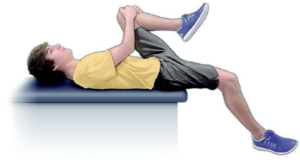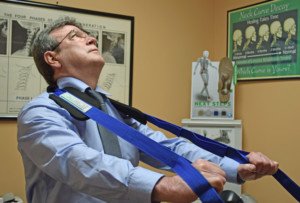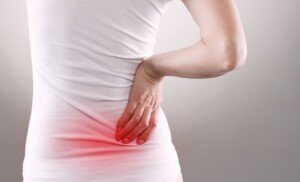Here’s how to eliminate low back pain when you wake up in the morning.
Your low back should not hurt or ache when you get up after a night’s sleep.
To help solve the problem of low back pain or aching in the morning, you should first know the causes.
You can be the fittest person in the world and still suffer from this problem.
However, having de-conditioned back muscles will predispose you to discomfort in the morning.
“The lower back is a very complicated structure consisting of bones, joints, discs, nerves, ligaments and muscles, to name a few,” says Dr. Tom Carpenter, corrective exercise specialist, certified personal trainer and chiropractor, inventor of Stand Corrected™, a portable harness-like stretching tool that helps alleviate back, neck and shoulder pain.
“Assuming your morning back pain is not caused by anything serious, there are some other things that could be the culprit,” continues Dr. Carpenter.
Causes of Low Back Pain in the Morning
1 What You’re Sleeping On
“The first of these might be your mattress and/or pillow. I personally use a firm mattress topped with 2” memory foam and find this very comfortable and supportive,” says Dr. Carpenter.
“It’s important that your back is getting the proper support while you sleep. After all, we spend approximately one-third of our life sleeping.
“Mattresses and foam can deform over time and should be replaced as they wear out. If you notice that yours is becoming bowl shaped or indented in one area, it’s time to go shopping for a new one.
“Also, remember to turn the mattress regularly.”
If a firm mattress doesn’t help solve the problem, you may want to consider sleeping with your torso elevated to create some flexion in your lower spine.
Prolonged low back extension due to lying on your back on a “hard” surface can lead to aching muscles.
Torso elevation will prevent that little arch in your low back from forming.
Options are sleeping against a wedge pillow; in a bed with an adjustable head; or in a recliner chair.
2 Sleep Position
“In addition, use a good supportive cervical pillow that allows you to sleep in an anatomically neutral position, and never sleep on your stomach. Side or back sleeping is okay, but never on the stomach!

“When sleeping on your side, try putting a thin pillow between the knees to take the pressure off of the lower back.
“If you sit for a good portion of the day and then sleep on your side with your knees bent, then the psoas muscles (you have a right and a left) could be causing your pain.
“These muscles are powerful hip flexors which are necessary for bending and bringing the knees up when walking, running and climbing. They help to stabilizing the core as well.
“They are attached to all of the lower back vertebra and travel down to the hip area.
“When you keep them flexed for extended periods of time, such as prolonged sitting and sleeping with knees bent, they can become shortened and eventually overly tightened, pulling on the spine and causing back pain.”
Psoas Muscle Stretch in Your Bed
“There are several ways to stretch the psoas safely and effectively,” says Dr. Carpenter.
“One simple psoas stretch can be performed by lying face up near the edge of the bed.
“Bring one knee to your chest and let the other leg gently drop off the edge of the mattress.

“Let the extended leg gradually stretch for about 10-15 seconds, and then repeat with the other leg.
“If you feel any pain, stop immediately and consider discussing it with a back specialist.
“As we sleep, the discs between the vertebra in the back will tend to rehydrate, causing them to swell.
“This natural swelling can put additional pressure on areas of the back that might be susceptible to discomfort, such as from bulging discs, strain muscles or ligaments, old injuries, poorly conditioned posture muscles or a variety of other reasons.
“As we move around, this extra fluid gradually dissipates, and the back tends to loosen up, so to speak.
Two More Simple Stretches
“Two simple stretches that can help with this loosening process are the sun salutation stretch and cat/dog stretch,” says Dr. Carpenter.
“Repeat this several times until the back feels looser. This motion tends to elongate the spine and traction of the discs.”
Dr. Carpenter continues: “For the cat/dog stretch, you position yourself on your hands and knees.
“First, breathe in while gently dropping the stomach down and lifting the head up. Hold for 2-3 seconds.
“Next, while exhaling, tighten the stomach muscles and arch the lower back upwards (like a cat) while letting the head drop all the way down. Repeat this several times.
“Again, this motion will help to traction the lower spine and help the back to relax.”
For best results, you should stay consistent with these two exercises.
When you practice consistency and patience, these two exercises will help your morning back pain or aches should disappear.

Photo credit: Aleesia Forni
Based upon 30+ years of experience, Dr. Carpenter’s practice approach reflects his belief that restoring optimum health and function will enable his patients to enjoy a much greater amount of vitality and wellness. Chiropractic care is true health care, not sick care!
 Lorra Garrick has been covering medical, fitness and cybersecurity topics for many years, having written thousands of articles for print magazines and websites, including as a ghostwriter. She’s also a former ACE-certified personal trainer.
Lorra Garrick has been covering medical, fitness and cybersecurity topics for many years, having written thousands of articles for print magazines and websites, including as a ghostwriter. She’s also a former ACE-certified personal trainer.










































